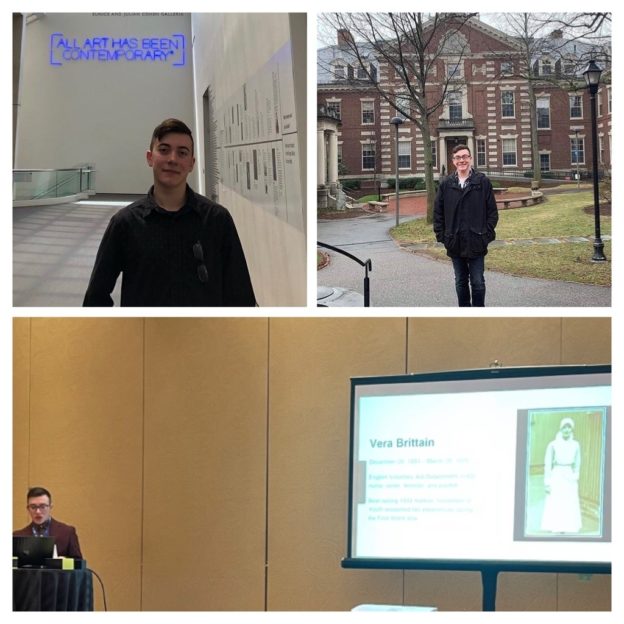1. Why did you apply to HASTAC?
I was interested in working more closely with methods of digital literacy in the classroom, and since classes form a sort of community, I wanted to be involved with others who were experimenting with the digital humanities in their work, since intellectual cross-pollination is so integral to my work.
I am invested in public scholarship, thus the prospect of writing a blog where I discuss my dissertation and my pedagogy seems to be a wonderful way to connect with other scholars. I bring digital humanities techniques into the classroom through explorations in digital archives. I am interested in the intersection of the digital humanities and pedagogy in the college writing classroom, and sharing my perspective with other scholars in the field. In addition, I would like to create a digital syllabus on the topic of shell-shock in literature.
2. What has been your favorite course so far as an instructor or student? Why?
So far, my favorite course which I have taught was Advanced Writing Across the Humanities at Northeastern University. Within this class, which asks students to engage with scholarly texts as writers, readers, and as a part of an ongoing scholarly conversation, I introduced students to multiple forms, including the critical analysis, the scholarly essay, the annotated bibliography, and the abstract.
One assignment involved using metadata from library sources to model a conversation, by showing which provided pathways to other authors, who were writing within the same conversation. Towards these goals, we worked collaboratively to analyze essays, break down genres into their discrete parts, and became our own community of writers.
3. What do you want to do after you graduate?
I would like to continue my research and teaching within higher education, but more specifically, I’d like to publish in venues apart from traditional academic publishing, especially in open access forums. One example of such work is my essay, “Fragments of A Great Confusion”: The Psychological War Sketches of Mary Borden, which appeared on the open-access site, Lost Modernists.
4. What’s something that people would be surprised to know about you?
I actually hold a minor in botany, and in my spare time, I like practicing plant identification.
5. What are some things that you wish you knew before you got into graduate school?
I wish I had known that your dissertation project doesn’t need to reflect the sum of your disciplinary fields or interest, and that sometimes, your best resources are not books, but the people around you.
6. How does digital scholarship fit into your research or teaching?
I understand digital scholarship as a means of rendering archives, data visualization, and other means of recording information in a more accessible and tangible way for students. In my research, I use digital scholarship in the form of digital exhibits as a means of ordering and arranging data to provide a clear picture of syllabi and archival collections. Much of my work is intertextual, building on legislative, medical, and literary depictions of shell-shock in the aftermath of the first world war, so digital methods provide a nod to this intertextuality, allowing me to create digital syllabi and online exhibits.
My archive assignment is a great example of how digital scholarship informs much of my pedagogy. For many students, consulting archives for their research feels like an overwhelming undertaking. In archive assignments, I ask students look at a selection of disparate archives, so that they have a better sense of what is out there, and since many digital archives are open-access, my students can approach archives without barriers of access. In addition, we are able to look at each object, not as disconnected, but connected to other objects, as archival objects, as we assess metadata and tags. These discussions then scaffold towards discussions of student writing and how their own work takes place within an ongoing scholarly conversation.
In one course (Introduction to Women’s, Gender, and Sexuality studies), I designed a set of assignments which asked students to look at an online archive and select an item within the archive. They were then asked to analyze the item, locate it within the context of the archive’s goals, and propose a means through which the item constituted a particular argument.
7. What do you hope to accomplish with your research or teaching?
In my research, I hope to build upon a foundation of interdisciplinary research through the framework of gender failure to re-examine our understanding of shell-shock and its literary representations in the aftermath of the First World War.
In my teaching, I hope to give students the tools they need to approach language with a critical lens, providing an accessible classroom which allows students to approach research through a model of the classroom that treats students as experts of their own learning styles, and affirms their own right to language and self-expression.
8. What are you currently reading, watching, or listening to?
I just finished Upstream by Mary Oliver, which is a lyrical collection of essays on the natural, artistic, and spiritual world. One essay that stands out is “Bird,” (first published as “The Christmas Bird”), a haunting piece in which Oliver describes her efforts to save a gull with two broken wings. In other essays in the collection, she traces her artistic inspiration to the natural world through the writing of others, including her “friend Walt Whitman,” saying, “I could not be a poet without the natural world. Someone else could. But not me.”
